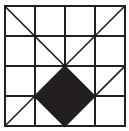1998 AJHSME Problems/Problem 13
Contents
[hide]Problem
What is the ratio of the area of the shaded square to the area of the large square? (The figure is drawn to scale)
![[asy] draw((0,0)--(0,4)--(4,4)--(4,0)--cycle); draw((0,0)--(4,4)); draw((0,4)--(3,1)--(3,3)); draw((1,1)--(2,0)--(4,2)); fill((1,1)--(2,0)--(3,1)--(2,2)--cycle,black); [/asy]](http://latex.artofproblemsolving.com/5/9/b/59b849abaccf2ca59a38fc1cb6adf63f12eae897.png)
![]()
Solutions
Solution 1
We can divide the large square into quarters by diagonals.
Then, in ![]() the area of the big square, the little square would have
the area of the big square, the little square would have ![]() the area.
the area.
![]()
Solution 2
Answer: C
Divide the square into 16 smaller squares as shown. The shaded square is formed from 4 half-squares, so its area is 2. The ratio 2 to 16 is 1/8.
See also
| 1998 AJHSME (Problems • Answer Key • Resources) | ||
| Preceded by Problem 12 |
Followed by Problem 14 | |
| 1 • 2 • 3 • 4 • 5 • 6 • 7 • 8 • 9 • 10 • 11 • 12 • 13 • 14 • 15 • 16 • 17 • 18 • 19 • 20 • 21 • 22 • 23 • 24 • 25 | ||
| All AJHSME/AMC 8 Problems and Solutions | ||
The problems on this page are copyrighted by the Mathematical Association of America's American Mathematics Competitions. ![]()










